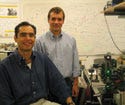Nanostrings on Pitch for Measuring Viruses
R&D DIGEST
October 1, 2006
|
Kamil Ekinci and Todd Murray of Boston University believe that a nanostring and laser apparatus can help measure and identify viruses and other biomolecules. The system operates using the same principles as string-based musical instruments. |
Individual nanowires could be tapped—or rather, plucked—to create extremely sensitive biosensors for measuring individual viruses or other biomolecules. Some day, these could improve diagnostic testing systems.
Boston University researchers Todd Murray, PhD; Kamil Ekinci, PhD; and Ashwinkumar Sampathkumar have created nanowires that are 4–10 µm long and 250 nm in diameter. The finely tuned nanowires are made from light-sensitive silicon coated with a thin layer of chromium. They can be manipulated by lasers and monitored so that changes as a result of any tiny mass (such as a biomolecule) sticking to them can be measured.
“Sensing small masses using a vibrating resonant device is based on a very simple concept: if a small mass is added to the vibrating mass of the resonator, the resonator becomes heavier and its resonance frequency goes down,” says Murray, an assistant professor of aerospace and mechanical engineering and director of the laser acoustic lab.
The lasers cause the nanowires to vibrate at certain frequencies, depending on the wire's mass, length, structure, and tension (akin to changing notes on a guitar). However, these notes are at frequencies beyond the limits of human hearing. Those measurements, say the researchers, can help scientists better understand the weight of the biomolecule.
Chromium on the nanowire expands more rapidly than the silicon, causing the wire to bend when a laser hits it. If the laser pulses are focused on one 1-µm spot, the wire will vibrate in a uniform fashion. To measure the size of the vibrations, the same spot is monitored using a green laser beam.
The strength of the vibrations increases as the nanowire approaches its resonant frequency, and researchers predict it should be possible to weigh a virus or large biomolecule by attaching it to the wire and measuring changes to the resonant frequency.
Ekinci, who is also an assistant professor of aerospace and mechanical engineering, was part of a group that demonstrated that the frequency of nanowires' vibration changes when xenon atoms are deposited onto them. They were able to weigh as few as 30 xenon atoms—the equivalent of just 7 zeptograms, or 7 × 10-21–grams. However, their experiments involved suspending the nanowires in a strong magnetic field and passing tiny electrical charges through them. The technique used now is far simpler and can be done at ambient temperatures.
|
(click to enlarge) The diagram on the left shows the initial setup of the system and the nanostring in stasis. The right-hand diagram shows the resonance line shapes at the point of displacement. The vibrations increase as the nanowire approaches its resonant frequency. |
Potential applications, say the researchers, include ultrasensitive detection of biological and chemical species. “Our current work is focused on exciting the nanostrings and detecting the resulting vibrations using laser sources,” says Murray. “This technique enables us to control the nanostructures remotely and eliminates the need for electrical contacts. In particular, we feel that the optical approach is particularly well suited for the simultaneous operation of arrays of nanoelectromechanical systems (NEMS) structures.”
The team has yet to demonstrate their theories experimentally, however, and many challenges remain. First, explains Murray, most biochemical sensing applications operate in water because most analyte molecules exist only in water. The problem is that water movement affects the nanoscale motion, competing with the sensor data. “The liquid not only slows the resonator by sticking to the resonator, but also reduces its sensing capabilities by dissipating the energy of motion,” Murray says. He notes that good physical understanding of such fluidic effects on nanoscale motion will require more studies.
Second, the nanosensor element must be made selective to the analyte of interest. “While some progress has been made, the fabrication of functionalized NEMS devices remains a key technological challenge that must be overcome before these devices can be incorporated into diagnostic testing systems,” Murray says.
The researchers have received a grant from the National Science Foundation to develop an optical system suitable for excitation and detection of large-area NEMS arrays in parallel. This is because the data from a single sensor are not efficient. Without multiple arrays, the tests would take too long.
The paper was presented at the Acoustical Society of America meeting on June 6, 2006.
Copyright ©2006 Medical Device & Diagnostic Industry
About the Author(s)
You May Also Like



